Poinsettia Video: Finishing Strong & Successful Shipping
In Episode #35 of our comprehensive Poinsettia Production Series, experts James Doukas, Jason Twaddell and Gary Vollmer from Ball Seed and Selecta One help you put finishing touches on your poinsettia crop and send it out the door looking great and ready to hold up at retail until the point of sale. Your poinsettia season is just about over, and the IMPROVING SHELF LIFE video takes you to the finish line.
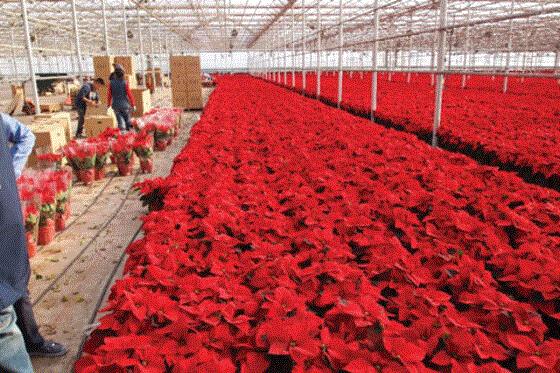
Your goals at this final stage of the crop are feeding to the end, keeping disease in check and storing and shipping cool. Here is all the detailed info covered in this short video:
-
Root protection
-
End-of-the-line cool down
-
Controlling humidity
-
Watch bracts for botrytis
-
Calcium chloride sprays
-
Late paclo drench
-
Feeding to the bitter end
-
Store and ship cool for best results
Nick’s Tip of the Week: Getting Ready for Spring Part 2—Interpreting Water Tests (Alkalinity)
Each week, I’ll work with my buddy Nick Flax, a technical services expert at Ball, to share a concern that’s come up during one of his numerous calls with growers across North America. This week, he’s continuing his spring 2023 kick-off series with a discussion of water alkalinity.
PROBLEM: Last week, I wrote about the importance of understanding your greenhouse’s water quality to help guide crop management and stay ahead of production issues. (If you didn’t catch last week’s tip, be sure to check it out in the Tech On Demand newsletter archives.) This week's topic: Once you get your water tested, how do you interpret the results?
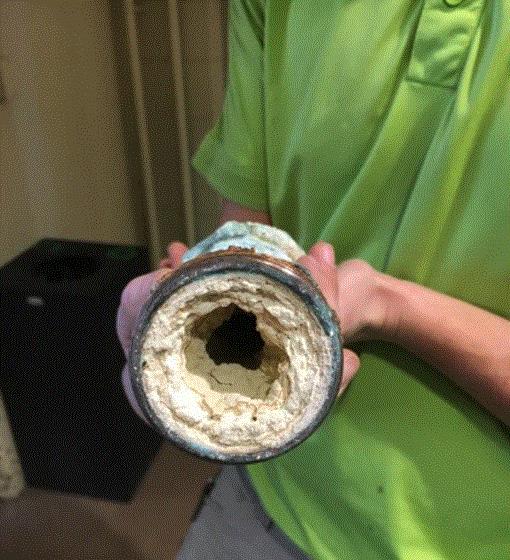
NICK’S TIP: Diagnostic reports can contain a LOT of information; and for the most part, no two labs report the exact same sets of parameters, present data using the same units, or format their reports the same as other labs. So how are you supposed to glean actionable info from a water test report with so much info and so little consistence between labs? This week’s tip will highlight key info in water analyses, which parameters to pay special attention to, and general thresholds that indicate a need for additional management.
Alkalinity 101
For greenhouse growers, alkalinity is arguably the most important water quality parameter to monitor and manage. Not to be confused with the term “alkaline” (meaning a pH above 7.0), alkalinity is a measure of your water’s buffering capacity—its ability to neutralize acid. Alkalinity is most often reported as ppm CaCO3 (sometimes written as mg/L; 1 ppm = 1 mg/L) or meq/L. This value indicates the concentration of calcium, magnesium and sodium carbonates or bicarbonates present in your water.
As water reacts with things like fertilizer (water-soluble [WSF] or controlled release [CRF]), soil amendments, acids produced by roots in the growing media, and the growing media itself, these carbonates/bicarbonates break down, causing soil pH to increase over time. Keep the following in mind as you review alkalinity on your water report:
-
#1 take-home message: Too-high alkalinity often means more crop challenges.
-
~50 ppm CaCO3 = 1 meq/L (milliequivalent)
Ideal alkalinity levels for greenhouse growers range from about 50 to 75 ppm CaCO3.
-
Alkalinity higher than 75 ppm often makes high-quality young plant production challenging.
-
Alkalinity between 75 and 150 ppm is often workable for finished plant production simply by using an acidic fertilizer formulation. Minimal intervention is generally needed, but low-pH-loving crops (such as petunia and calibrachoa) may develop iron (Fe) deficiency later in production if alkalinity is on the higher end of this range.
Alkalinity greater than 150 ppm often requires raw water to be acidified through a separate injection system before blending with WSF.
-
AlkCalc is a great online tool that you can use to determine how much acid is needed to bring your alkalinity down to a manageable level. Check it out HERE.
-
Sulfuric acid is one of the preferred acids among growers, as it is relatively easy to source and does not heavily alter the nutrient balance of your fertilizer solution.
-
Phosphoric and nitric acids are other options commonly used for to manage alkalinity. However, these will increase the total phosphorus (P) and nitrogen (N) levels (respectively) in your feed. For example (per AlkCalc): If alkalinity is 180 ppm CaCO3 and you want to lower it to 125 ppm, sulfuric acid will add about 27 ppm of sulfur (S), whereas phosphoric acid will add about 50 ppm of P. Adding 27 ppm of S likely won’t change anything, but 50 ppm of P is a LOT more P than plants need, and it will undoubtedly have a negative impact on crop quality.
While less common, too-low alkalinity (less than 40 ppm CaCO3) presents its own unique set of challenges. Think of your target soil pH like a lane in a bowling alley and appropriate amounts of alkalinity in your water like bumpers that pop up each time it’s your turn to roll the ball.
-
Bumpers prevent your ball from rolling into the gutter and help keep the ball (roughly) in the center of the lane. In a similar way, alkalinity helps keep your soil pH out of the gutter by neutralizing various acids in the media.
-
To replenish your buffer (or get the bumpers to “pop up”), small doses of alkalinity need to be added to the media at each irrigation.
-
Since low-alkalinity water does not replenish much buffering capacity (or raise the bumpers), it becomes easier for soil pH to spike or crash as your media’s lime charge depletes. In turn, this causes nutrient deficiencies and toxicities to induce very quickly as the soil pH swings up and down, especially as the crop matures and acidic reactions (like respiration and cation uptake) in the root zone occur in greater quantity.
When alkalinity in your water is excessively high (higher than 250 ppm CaCO3), acid injection alone may not be enough to correct it without being cost-prohibitive or causing nutrient imbalances in your feed program.
-
In this situation, use of reverse osmosis (RO) is often necessary, despite the typically high cost of installing and maintaining these systems.
-
Blending RO water with raw water can reduce alkalinity to acceptable levels for good crop growth or make it feasible for acid injection and fertilizer selection to do the rest.
Alkalinity is an important parameter, so take some time to digest this. Next week, we’ll pick back up and go over other critical factors to look for and manage based on your water test results. See you next Friday for Part 3, and I hope you had a very Happy Thanksgiving!

First-Year Flowering Perennials: A Deep Dive
In order to generate impulse sales at retail, you and your production team need to be on your game to hit key sales windows. First-year flowering (FYF) perennials are a critical piece of this puzzle these days, thanks to breakthroughs in breeding and scheduling.
Tech On Demand has a comprehensive series of videos taking a close look at new developments in FYF perennials, featuring Tech On Demand perennial expert Chris Fifo of Kieft Seed & Darwin Perennials. His goal is to set you up for success in 2023.
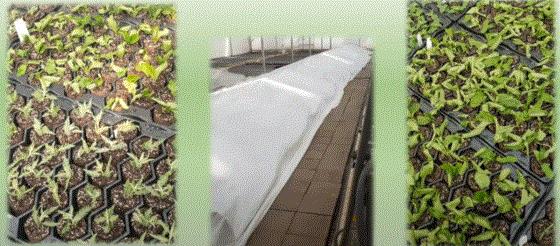
Chris covers all you need to know to grow your best crops ever in an easy and profitable way. Breeding innovations in FYF perennials from seed, vegetative cuttings and vernalized liners are helping take the guesswork out of perennials for the spring and fall sales windows. But this requires education to reduce the learning curve for you and your team.
Take some time to review these videos before you head into spring (and summer and fall) production.

Quick Tech Tip: Leaf Drop on Roses
I haven't written much about rose production, because this newsletter has tended to focus on annuals and perennials, but the Tech On Demand team works with growers on a much wider range of crops. So when one of our experts helped a grower diagnose and correct a problem on a rose crop, I thought it might be something others encounter and decided to include it this week.
No one who grows roses wants to see leaves suddenly drop off, leaving sticks in pots, like in the photo. After working with the grower to test the soil, it was determined the EC was incredibly high (2-3.2 mS/cm) and the pH really low (4.3). You can also see an excess of controlled release fertilizer (CRF) on top of the media in the pots.
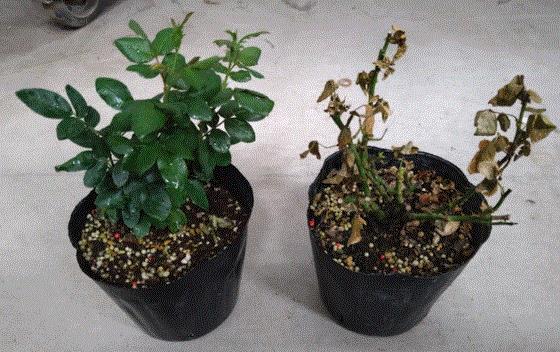
High salts in the growing media, along with the low pH, often leads to root diseases like Pythium and Phytophthora. One of these could easily lead to the leaf drop experienced by this grower. When you see this, your best bets to rescue the crop include flushing with clear water to drop the EC, then drenching with a fungicide. Our experts also recommended applying either mono and dipotassium salts of phosphorous acid or aluminum in combination with the fungicide.
After the drench is complete, it’s critical to regulate irrigation carefully to avoid keeping the media too wet between waterings. New root initiation should be visible two weeks after drenching. Another good idea would be to treat with limestone to increase the soil pH.

Nutritional Strategies for Tropicals
Tropicals and foliage expert Lynn Griffith wrote an article for the current issue of GrowerTalks that contains so much fantastic information that I felt the need to call your attention to it. If you produce tropical plants, this is a concise discussion of critical nutrition that you’ll want to post and share with your team.
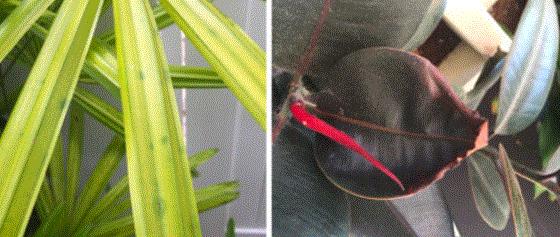
In the article, Lynn covers fertilizer strategies, the important macro- and micronutrients you need for optimum health, some crop-specific plans, and general best practices. He also digs into deficiencies and offers suggestions for turning these issues around.
The topic of phosphorus comes up, and here’s what Lynn has to say about that. “Plants, including tropicals, generally need significantly less phosphorus than nitrogen or potassium. However, a few factors need to be considered.” Those factors are:
-
Most potting media ingredients are deficient in available phosphorus.
-
Plants especially need phosphorus early in production to establish an abundant root system.
-
Phosphorus tends to leach from most potting media. Symptoms of phosphorus deficiency aren’t very common, though you may see it in some dracaena varieties. It shows up as a reddish or purple color in the older leaves.
Read Lynn's FULL ARTICLE here.

Finish Line ...
As you spend time in the next few weeks attending holiday parties, spending time with friends and family and sending the last of your poinsettias out the door, it’s a good time to reflect back on 2022. At the end of just about every crop-specific article, video, podcast and educational session, the presenter or writer tends to suggest a debrief of some sort. Hopefully you and your team has taken good notes through the production cycle—indicating problems that arose, positive results from new protocols, or ideas for improvement next year. Season recaps are really important, and clear, concise notes always help reduce the risk of repeating mistakes in the future.
Along those lines, I encourage you to join our GREENHOUSE TECH TEAM FACEBOOK GROUP and the more than 4,300 greenhouse professionals around the world who use this resource to ask questions, share solutions and search for topics related to the issue at hand. The group is positive and always willing to share tips and tricks to help you navigate the crazy world of seasonal greenhouse production. With more than three years of content, chances are you’ll find the info you need, when you need it.
For your benefit, the group is “private” to reduce the number of hobbyists and home gardeners and keep the conversation focused on topics pertinent to greenhouse professionals. Thus, you will need to answer a few questions before being accepted as a member. As the administrator, I tend to approve requests within 24 hours.

Be sure to use the search function and check out the list of topics on the right side of the page. I try to keep things organized—although it’s sort of like herding cats.




Please feel free to send your comments, constructive criticism and topic ideas to me at bcalkins@ballhort.com.

Bill Calkins
Editor - Tech On Demand
This email was received by you and 26,360 other fine subscribers!
If you're interested in advertising in Tech On Demand, contact Kim Brown ASAP and she'll hook you up.